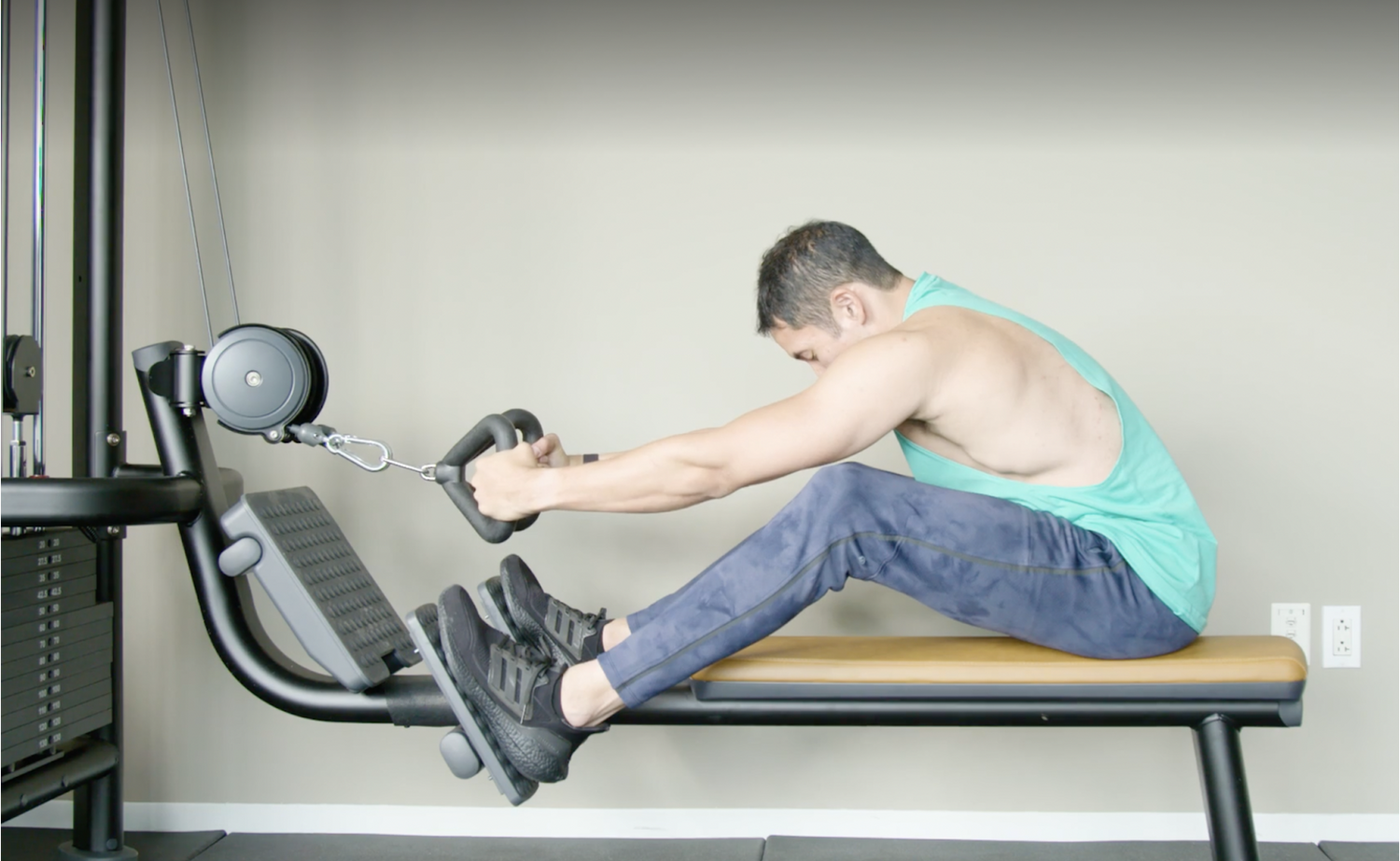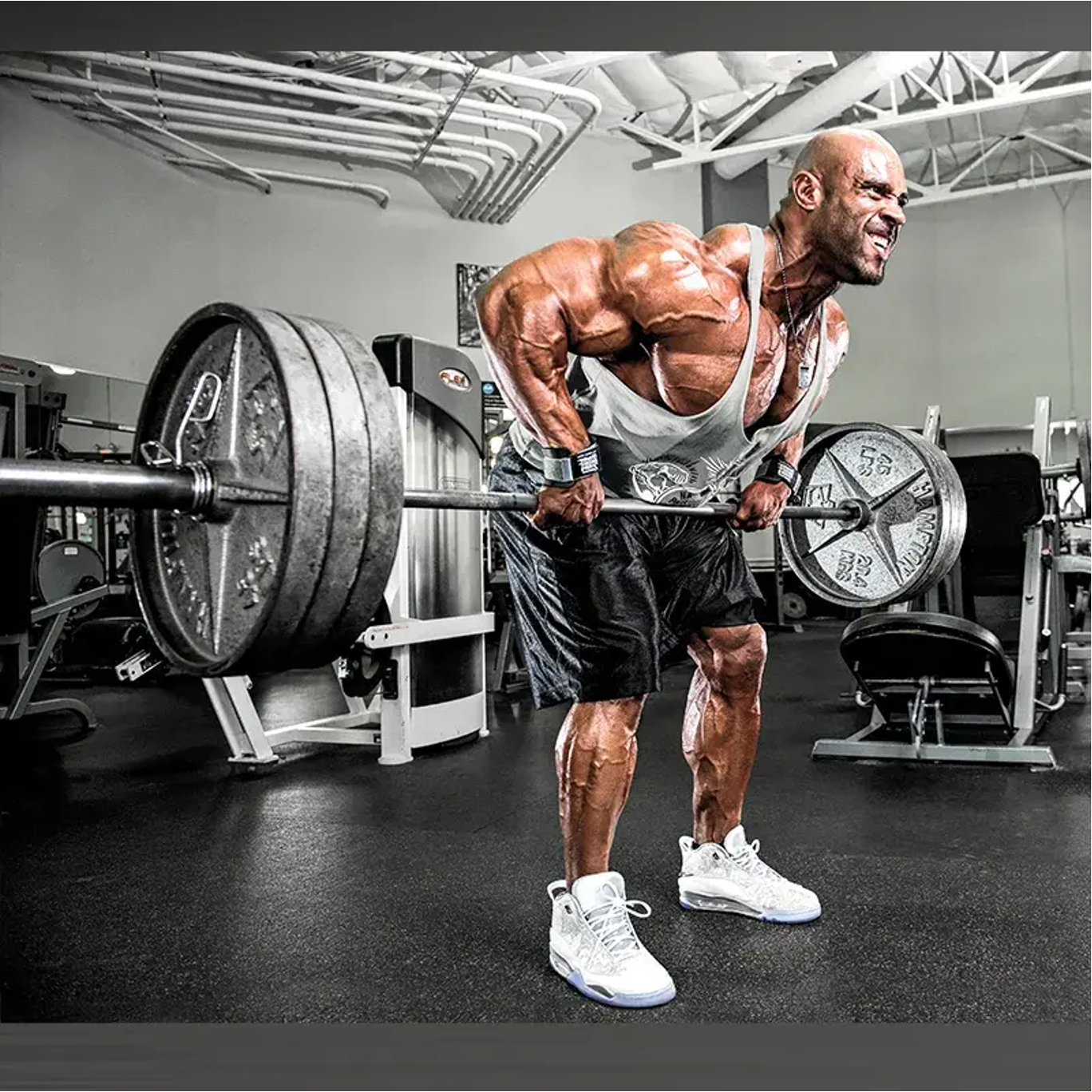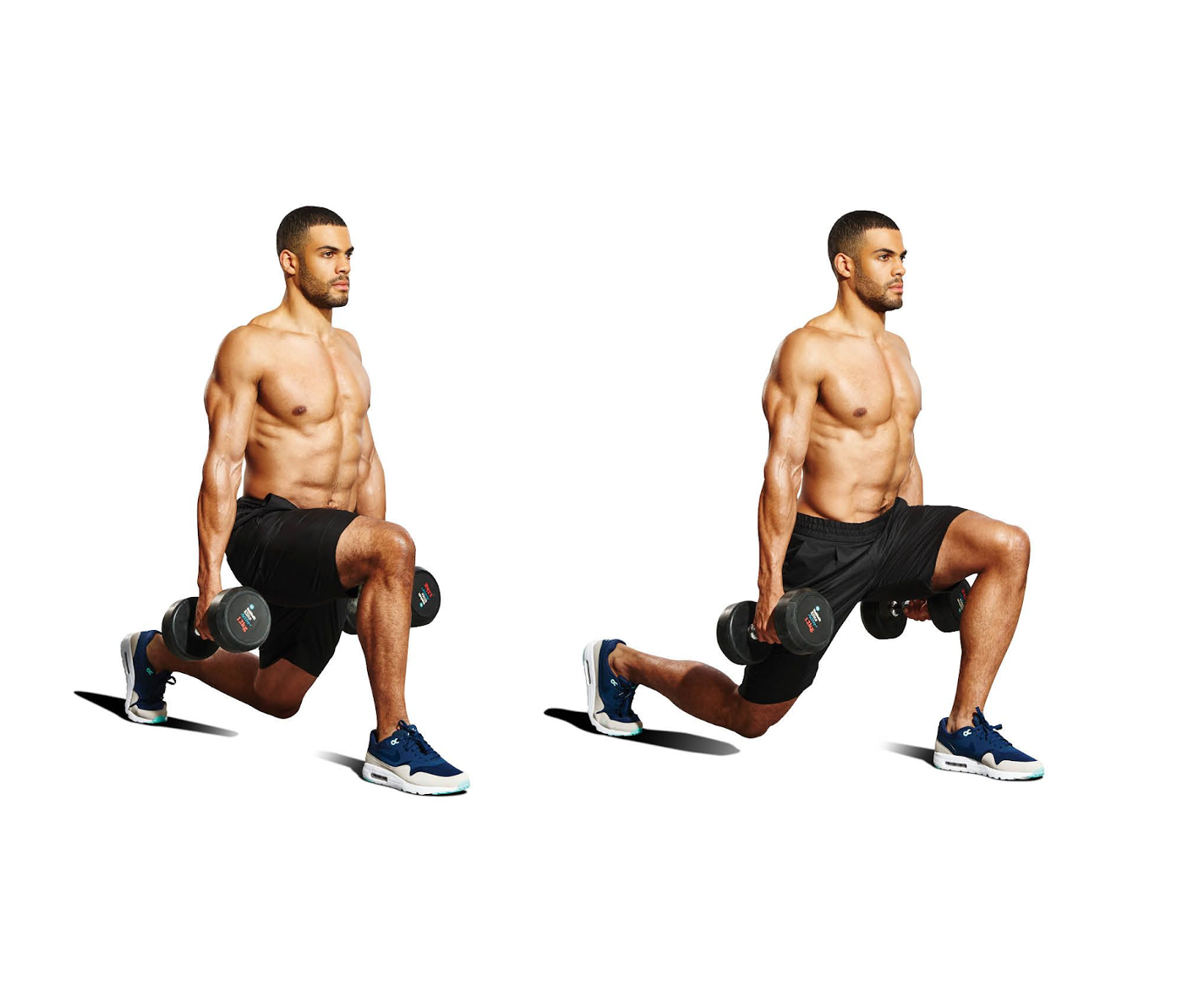Key Takeaways
- Seated rows are like training wheels for your back: stable, controlled, and perfect for beginners or anyone whose lower back is already angry from sitting all day.
- Bent over rows engage more total muscle mass, including the core and lower body, creating a more functional strength exercise.
- While both exercises target the latissimus dorsi and rhomboids, bent over rows activate more of the posterior chain.
- You can perform both exercises on the same day for comprehensive back development when programmed correctly.
- SOLE’s Olympic barbell and adjustable bench create the perfect one-two punch for complete back development. Use the barbell for heavy bent over rows that build total-body strength, then flip the bench to an incline for chest-supported rows that isolate your back muscles without lower back stress.
Back Training Face-Off
Why Back Training Matters More Than You Think
Your back isn't just about looking good in a tank top (though that's a nice bonus). It's the foundation of nearly everything you do in the gym and in life. Every time you deadlift, squat, or even just carry groceries, your back muscles are working overtime to keep you upright and injury-free.
Modern life has turned most of us into human question marks that are hunched over computers, slouched in cars, and generally living in positions that would make our ancestors weep. This forward-head, rounded-shoulder posture doesn't just look bad; it creates muscle imbalances that can lead to pain, poor performance, and long-term joint problems.
Strong back muscles pull your shoulders back where they belong, improve your posture, and create the structural foundation for bigger lifts and better athletic performance. Plus, there's something primal and satisfying about developing the kind of back strength that makes you feel capable of handling whatever life throws at you.
|
At SOLE, we're proud to offer the best exercise equipment for your home or gym. Our machines are built to meet the highest quality and performance standards, making them perfect for fitness enthusiasts at any level. SOLE Products
|
Seated Row Basics
The seated row is performed on a cable machine or specialized rowing machine that provides a stable platform. You sit with your feet braced against footplates, knees slightly bent, and grab the handle with both hands. The movement involves pulling the handle toward your midsection while maintaining an upright torso, then controlling the weight as you extend your arms back to the starting position.
Proper Form
Proper seated row form starts with positioning yourself at the appropriate distance from the weight stack. Your knees should be slightly bent, and your back should maintain its natural curve throughout the movement. Grasp the handle with a neutral grip (palms facing each other) or an overhand grip depending on your preference and the attachment you're using.
As you pull the handle toward your abdomen, focus on squeezing your shoulder blades together rather than just moving your arms. Your elbows should travel close to your sides, not flaring outward. Avoid the common mistake of using momentum by rocking your torso forward and backward. This reduces the effectiveness of the exercise and increases injury risk.
The controlled return is just as important as the pull. Resist the temptation to let the weight stack drop quickly, and instead focus on a slow, controlled extension of your arms. Maintain tension in your back muscles throughout the entire movement.
Muscles Worked
The seated row primarily targets the middle back muscles, including the rhomboids and middle trapezius. It also substantially engages the latissimus dorsi (lats), posterior deltoids, and biceps as secondary movers.
Because of the stable seated position, the exercise effectively isolates these back muscles with minimal involvement from the lower body or core, making it an excellent choice for targeted back development.
Key Benefits
First, the supported position reduces stress on the lower back, making it accessible for those with back issues or beginners still developing core strength.
The fixed movement path also helps maintain proper form, reducing injury risk while ensuring consistent muscle activation.
Additionally, the seated position allows for greater focus on the mind-muscle connection, helping you really feel your back muscles working through each repetition.
Bent Over Row Explained
The bent over row is performed while standing, hinging at the hips with a flat back until your torso is nearly parallel to the floor. From this position, you pull a barbell, dumbbells, or other resistance toward your lower rib cage, then lower the weight with control. Unlike the seated variation, your body must stabilize itself throughout the entire movement.
The bent over row builds strength in both the upper and lower body. (Image courtesy of Men’s Health)
Correct Technique
Begin by standing with feet shoulder-width apart and knees slightly bent. Grasp your weight of choice with an overhand grip slightly wider than shoulder width. Hinge at your hips (not your waist) until your torso is at approximately a 45-degree angle to the floor, or nearly parallel for the more traditional version.
The secret to effective bent over rows is maintaining a neutral spine throughout the movement. Your back should be flat, not rounded, with chest up and shoulders pulled back. From this position, pull the weight up toward your lower rib cage by driving your elbows toward the ceiling, squeezing your shoulder blades together at the top of the movement.
Lower the weight with control, allowing your arms to fully extend without rounding your back or letting your chest drop.
The most common mistake is using momentum by swinging the torso or jerking the weight. This is a pulling exercise, not a swinging one.
Primary Muscles Targeted
The bent over row is a compound movement that targets the entire posterior chain. Primary muscles worked include the latissimus dorsi, rhomboids, trapezius, and rear deltoids. It also engages the erector spinae, hamstrings, glutes, and core muscles as stabilizers. The biceps also get substantial work as secondary movers during the pulling phase.
Unique Advantages
First, it's a true compound movement that builds functional strength across multiple muscle groups simultaneously. Second, it's highly versatile, allowing for variations with barbells, dumbbells, kettlebells, or even resistance bands.
The unstable nature of the exercise forces your body to develop stronger stabilizer muscles, improving overall athletic performance beyond just back strength.
Perhaps most importantly, the bent over row closely mimics many real-world lifting patterns, making it exceptional for developing practical strength that transfers to daily activities. This functional carryover is something machine-based exercises often lack.
Same-Day Training
A common question among fitness enthusiasts is whether seated rows and bent over rows can be effectively performed in the same workout. The answer is yes, with proper programming.
Is It Effective?
Combining seated rows and bent over rows in the same workout can be highly effective for developing complete back strength and muscle development. The different biomechanics of each exercise ensure you're challenging your back musculature in complementary ways.
The seated row's controlled environment allows for focused work on specific back muscles, while the bent over row's compound nature engages the entire posterior chain. Together, they create a synergistic effect that can lead to superior results compared to repeatedly performing just one variation.
If you are new to combining both exercises, a solid approach is to use bent over rows as your primary compound movement earlier in your workout, followed by seated rows as an accessory exercise. (Image courtesy of G4 Physio)
Optimal Sequencing
The order in which you perform these exercises matters significantly. For maximum strength development, most strength coaches recommend starting with the more technically demanding and higher-load exercise, typically the bent over row.
This allows you to tackle the more challenging movement when your energy and focus are at their peak, reducing injury risk and allowing for optimal performance.
If your primary goal is hypertrophy (muscle growth), you might consider pre-exhausting the back muscles with seated rows before moving to bent over rows. This approach ensures the target muscles reach sufficient fatigue even if core strength becomes a limiting factor during bent over rows.
Volume Considerations
When including both row variations in a single workout, total training volume requires careful management. As a general guideline, reduce the volume of each individual exercise by about 30% compared to what you would do if performing only one variation.
For example, if you perform 4 sets of bent over rows, you might do 3 sets of bent over rows and 3 sets of seated rows when combining them, rather than 4 sets of each.
Sample Back Workouts
The single-arm supported dumbbell row serves as an excellent bridge between fully supported seated rows and the more challenging bent over barbell row. Start with light weights on all exercises, focusing on feeling the target muscles work rather than moving heavy loads. (Image courtesy of Experience Life Magazine - Lifetime)
Beginner Routine
Perform this workout once per week, allowing 48–72 hours of recovery before training any pulling movements again.
- Seated Cable Row: 3 sets of 10–12 reps (focus on squeezing shoulder blades together)
- Lat Pulldown: 3 sets of 10–12 reps (wide grip)
- Supported Dumbbell Row: 3 sets of 10–12 reps per arm (one arm on bench)
- Light Bent Over Barbell Row: 2 sets of 10–12 reps (focus on perfect form)
- Back Extension: 2 sets of 12–15 reps (bodyweight only)
As technique improves and strength increases, gradually shift more emphasis toward the bent over row, eventually working up to 3 working sets in place of the 2 introductory sets.
Advanced Program
This can be performed once per week as a dedicated back day, or split across two sessions in an upper/lower or push/pull training split.
- Bent Over Barbell Row: 4 sets of 6–8 reps
- Weighted Pull-Ups: 4 sets of 6–8 reps
- Seated Cable Row (V-handle): 3 sets of 8–10 reps
- Single-Arm Dumbbell Row: 3 sets of 8–10 reps per side
- Chest-Supported T-Bar Row: 3 sets of 10–12 reps
- Straight-Arm Pulldown: 3 sets of 12–15 reps
Build Your Complete Back Setup with SOLE Strength Equipment
Ready to build a back that demands respect? SOLE's equipment gives you everything needed for both rowing variations without a gym membership. The SW111 Olympic Barbell is your bent over row workhorse. With its 194,000 PSI tensile strength, this bar won't bend or whip when you're pulling heavy, crucial for maintaining proper form during bent over rows.
SOLE strength equipment transforms any room into a complete back training facility.
The knurling on this barbell deserves special mention. It's aggressive enough to lock into your hands during heavy sets but won't shred your palms like a cheese grater. This matters when you're doing high-volume back work and your grip starts to fatigue. The balanced weight distribution also means the bar won't tip or roll when you set it down between sets.
For seated row alternatives and supported variations, the SW116 Weight Bench opens up a world of possibilities. Set it to an incline, lie face down, and you've created your own chest-supported row station; it has all the benefits of a seated row without needing a cable machine. With 9 adjustable positions, you can find the perfect angle for your body proportions and target different areas of your back.
The SW155 and SW180 Adjustable Dumbbells add another dimension to your back training. Single-arm dumbbell rows let you address imbalances between sides, while the quick-adjust system means you can drop weight instantly when form starts to break down. These dumbbells replace an entire rack of fixed weights, perfect for home training where space is at a premium.
Don't forget the SOLE Equipment Mat, essential for bent over rows at home. It gives you a stable, non-slip surface for your feet while protecting your floors from the barbell. At 36.5" x 78", you've got plenty of room for your stance and any weight drops.
The SOLE+ App comes included and brings you form tutorials and complete back workouts. You'll learn the subtle technique differences between row variations and how to progress safely from beginner to advanced loading.
Frequently Asked Questions (FAQs)
Which row builds more muscle mass?
Bent over rows build more total muscle mass because they engage multiple muscle groups simultaneously. The involvement of your entire posterior chain, core, and stabilizing muscles creates a greater overall growth stimulus. However, seated rows might produce slightly better isolation of specific back muscles like the rhomboids and mid-traps.
Can I do rows if I have lower back pain?
Many people with lower back pain can safely perform some variation of rowing exercises, but proper selection and modification are crucial. Seated rows are generally safer to start with as they provide external support for the spine.
Chest-supported rows (performed lying face down on an incline bench) offer another excellent alternative that removes almost all stress from the lower back while still effectively targeting the upper back muscles.
If you have chronic or acute back pain, consult with a physical therapist or sports medicine doctor before attempting bent over rows.
How often should I include rows in my workout?
For optimal back development, include some form of rowing movement in your training routine 2–3 times per week. This frequency provides sufficient stimulus for growth while allowing adequate recovery between sessions. Within a typical training split, you might perform heavy bent over rows on your primary back day, then include seated rows as an accessory movement on another upper body day later in the week.
Advanced lifters sometimes train back directly up to 3 times weekly, alternating between heavy, moderate, and lighter sessions to manage fatigue while maintaining high total volume.
Are rows enough for complete back development?
While rowing movements are essential for back development, they alone aren't sufficient for complete musculature development. The back consists of multiple muscle groups with different fiber orientations and functions.
For comprehensive development, combine horizontal pulling (rows) with vertical pulling (pull-ups, pulldowns), as well as specific work for the lower trapezius (face pulls, Y-raises) and erector spinae (back extensions, good mornings).
A complete back training program should include movements in multiple planes of motion to develop both thickness (rows) and width (pulldowns/pull-ups).
What SOLE equipment setup is best for comprehensive back training?
For the ultimate home back training setup, start with the SW111 Olympic Barbell—it's your foundation for bent over rows and will handle whatever weight you can throw at it. Add the SW116 Weight Bench to unlock chest-supported rows and other supported variations that let you train your back from multiple angles. The SW180 Adjustable Dumbbells give you unilateral training options and let you quickly adjust weight for drop sets or different exercises. Don't forget the Equipment Mat to protect your floors and provide stable footing. This setup gives you everything needed for both heavy compound rows and isolated back work.




Leave a comment
This site is protected by hCaptcha and the hCaptcha Privacy Policy and Terms of Service apply.